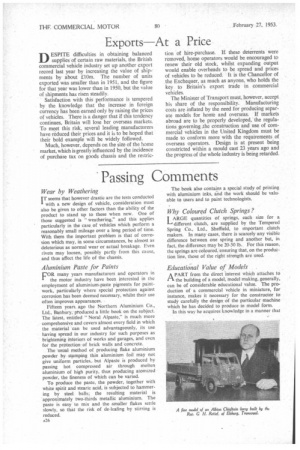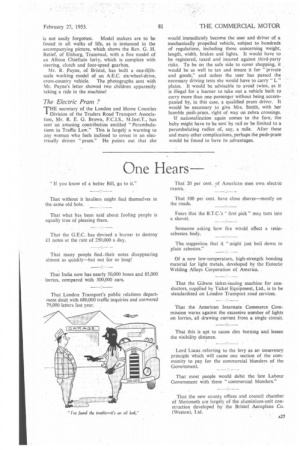Passing Comments
Page 28

Page 29

If you've noticed an error in this article please click here to report it so we can fix it.
Wear by Weathering
IT seems that however drastic are the tests conducted with a new design of vehicle, consideration mast also be given to other factors than the ability of the product to stand up to these when new. One of those suggested is "weathering." and this applies particularly in the case of vehicles which perform a reasonably small mileage over a long period of time. With them the important problem is that of corrosion which may, in some circumstances, be almost as deleterious as normal wear or actual breakage. Even rivets may loosen, possibly partly from this cause, and thus affect the life of the chassis.
Aluminium Paste for Paints
FOR many years manufacturers and operators in the motor industry have been interested in the employment of aluminium-paste pigments for paintwork, particularly where special protection against corrosion has been deemed necessary, whilst their use often improves appearances.
Fifteen years ago the Northern Aluminium Co., Ltd., Banbury, ptoduced a little book on the subject. The latest, entitled " Noral Alpastc," is much more comprehensive and covers almost every field in which the material 'can be used advantageously, its use having spread in our industry for such purposes as brightening interiors of works and garages, and even for the protectionof brick walls and concrete.
The "usual method of producing flake aluminium powder by stamping thin aluminium foil may not give uniform particles,. but Alpaste is produced by passing hot compressed air through molten aluminium of high purity, thus producing atomized powder, the fineness of which can be varied.
To produce the paste, the powder, together with white spirit and stearic acid, is subjected to hammering by steel balls; the resulting material is *approximately two-thirds metallic aluminium. The paste is easy to mix and the smaller flakes settle slowly, so that the risk of de-leafing by stirring is reduced.
A26 The book also contains a special study of printing with aluminium inks, and the work should be valuable to users and to paint technologists.
Why Coloured Clutch Springs?
LARGE quantities of springs, each size for a LARGE clutch, are supplied by the Tempered Spring Co., Ltd., Sheffield, to important clutch makers. In many cases, there is scarcely any visible difference between one spring and another but, in fact, the difference may be 20-50 lb. For this reason, the springs are coloured, ensuring that, on the production line, those of the right strength are used.
Educational Value of Models .
APART from the direct 'interest which attaches to the building of a model, model making, generally, can be of considerable educational value. The production of a commercial vehicle in miniature, for instance, makes it necessary for the constructor to study carefully the design of the particular machine which he has decided to produce in model form.
In this way he acquires knowledge in a manner that
is not easily forgotten. Model makers are to be
found in all walks of life, as is instanced in the accompanying picture, which shows the Rev. G. H. Retief, of Elsburg, Transvaal, with a fine model of an Albion Chieftain 'any, which is complete with steering, clutch and four-speed gearbox.
Mr. R. Payne, of Bristol, has built a one-fifthscale working model of an A.E.C. six-wheel-drive, cross-country vehicle. The photographs sent with Mr. Pa,yne's letter showed two children apparently taking a ride in the machine!
The Electric Pram ?
THE secretary of the London and Home Counties Division of the Traders Road Transport Association, Mr. R. E. G. Brown, F.C.I.S., M.Inst.T., has sent an amusing contribution entitled "Perambulations in Traffic Law." This is largelir a warning to any woman who feels inclined to invest in an electrically driven "pram." He points out that she would immediately become the user and driver of a mechanically propelled vehicle, subject to hundreds of regulations, including those concerning weight, length, width, brakes and lights. It would have to be registered, taxed and insured against third-party risks. To be on the safe side to cover shopping, it would be as well to tax and insure it for "private and goods," and unless the user has passed the necessary driving tests she would have to carry " L " plates. It would be advisable to avoid twins, as it is illegal for a learner to take out a vehicle built to carry more than one passenger without being accompanied by, in this case, a qualified pram driver. It would be necessary to give Mrs. Smith, with her humble push-pram, right of way on zebra crossings.
If nationalization again comes to the fore, the baby might have to be sent by rail or be limited to a perambulating radius of, say, a mile. After these and many other complications, perhaps the push-pram would be found to have its advantages.




















































































